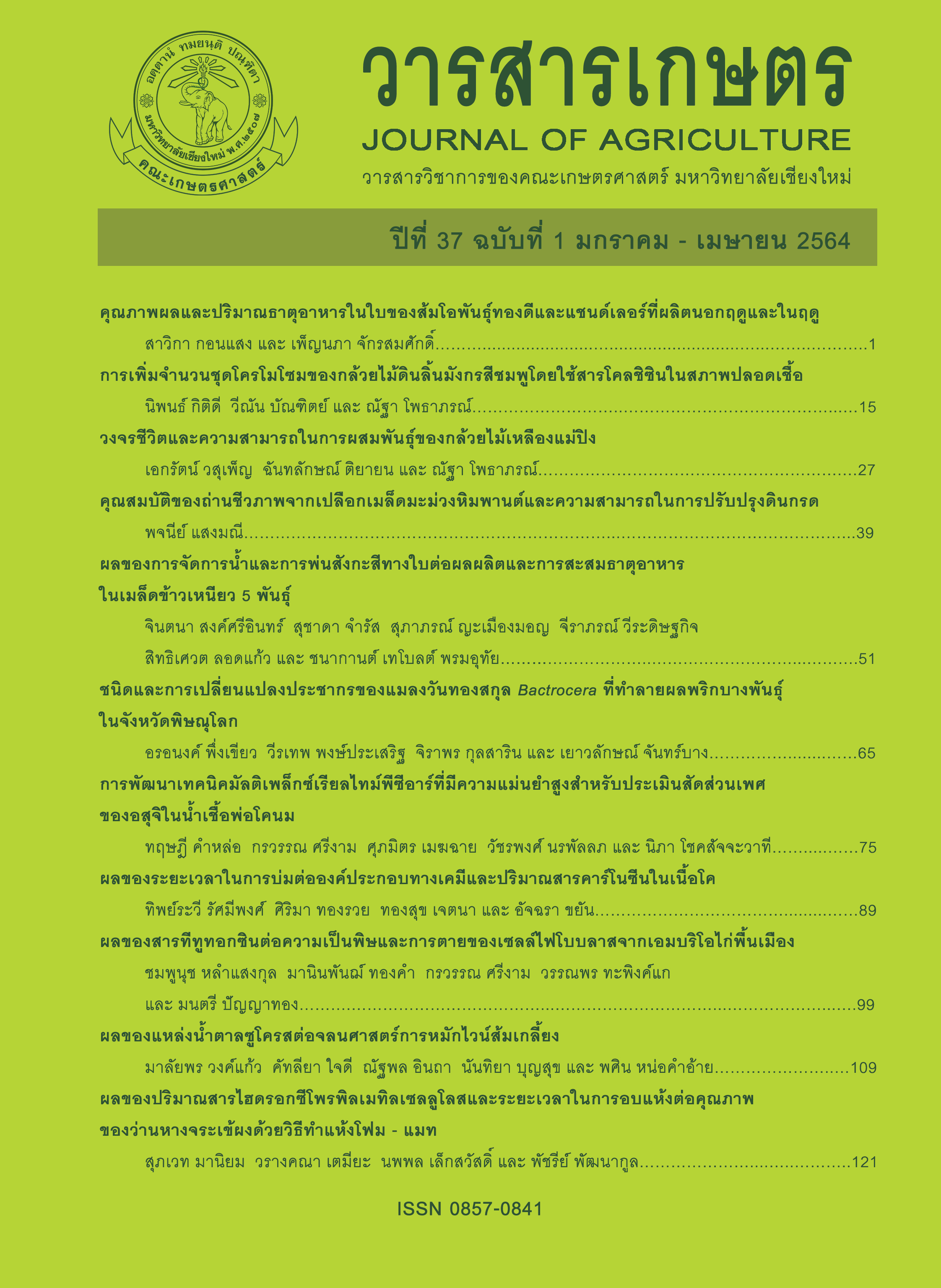Effects of T - 2 Toxin on Cytotoxicity and Apoptosis of Embryonic Fibroblast Cells Obtained from Native Chicken
Main Article Content
Abstract
The objective of this study was to determine the toxicity of T - 2 toxin in poultry. Chicken embryonic fibroblast (CEF) cells were derived from crossbred native chickens and used as a model for cytotoxicity evaluation of T - 2 toxins at various concentrations (0, 0.01, 0.1, 1, and 10 µg / ml) for 24 and 48 hours. Cytotoxicity of CEF was increased when exposed to increasing concentrations of T - 2 toxin. Cell viability of CEF was lower than 40 % and 20 % for all concentrations of T - 2 toxin at 24 and 48 hours, respectively. CEF cells were induced to death and mostly in the early apoptosis phase (62.27 %) by T - 2 toxin. The results indicated that crossbred native chickens were less resistant and more sensitive to T - 2 toxin. Therefore, the contamination caused by T - 2 toxin should be monitored in poultry feed as it may cause disease in chickens.
Article Details
References
Bouaziz, C., S. Abid-Essefi, A. Bouslimi, E. El Golli and H. Bacha. 2006. Cytotoxicity and related effects of T-2 toxin on cultured Vero cells. Toxicon 48(3): 343-352.
Desjardins, A.E., T.M. Hohn and S.P. McCormick. 1993. Trichothecene biosynthesis in Fusarium species: chemistry, genetics, and significance. Microbiology Reviews 57(3): 595-604.
Duke, R.C., D.M. Ojcius and J.D.-E. Young. 1996. Cell suicide in health and disease. Scientific American 275(6): 80-87.
Ezekiel, C.N., R. Bandyopadhyay, M. Sulyok, B. Warth and R. Krska. 2012. Fungal and bacterial metabolites in commercial poultry feed from Nigeria. Food Additives and Contaminants 29(8): 1288-1299.
Fang, H., Y. Wu, J. Guo, J. Rong, L. Ma, Z. Zhao, D. Zuo and S. Peng. 2012. T-2 toxin induces apoptosis in differentiated murine embryonic stem cells through reactive oxygen species-mediated mitochondrial pathway. Apoptosis 17(8): 895-907.
Gruber-Dorninger, C., T. Jenkins and G. Schatzmayr. 2019. Global mycotoxin occurrence in feed: a ten-year survey. Toxins 11(7): 375, doi: 10.3390/toxins11070375.
Kana, J.R., B.G.J. Gnonlonfin, J. Harvey, J. Wainaina, I. Wanjuki, R.A. Skilton and A. Teguia. 2013. Assessment of aflatoxin contamination of maize, peanut meal and poultry feed mixtures from different agroecological zones in Cameroon. Toxins 5(5): 884-894.
Khongthong, S., W. Khongthong and Y. Theaparat. 2019. Effect of cepharanthine on the cytotoxicity of doxorubicin in human b-lymphoma cells. Rajamangala University of Technology Srivijaya Research Journal 11(3): 451-460. (in Thai)
Labuda, R., A. Parich, E. Vekiru and D. Tancinova. 2005. Incidence of fumonisins, moniliformin and Fusarium species in poultry feed mixtures from Slovakia. Annals of Agricultural and Environmental Medicine 12(1): 81-86.
Mahdjoubi, C.K., N. Arroyo-Manzanares, N. Hamini-Kadar, A.M. García-Campaña, K. Mebrouk and L. Gámiz-Gracia. 2020. Multi-mycotoxin occurrence and exposure assessment approach in foodstuffs from Algeria. Toxins 12(3): 194, doi: 10.3390/toxins12030194.
Ozguner, F., A. Koyu and G. Cesur. 2005. Active smoking causes oxidative stress and decreases blood melatonin levels. Toxicology and Industrial Health 21(1-2): 21-26.
Rodrigues, I. and K. Naehrer. 2012. A three-year survey on the worldwide occurrence of mycotoxins in feedstuffs and feed. Toxins 4(9): 663-675.
Shareef, A.M. 2010. Molds and mycotoxins in poultry feeds from farms of potential mycotoxicosis. Iraqi Journal of Veterinary Sciences 24(1): 17-25.
Steel, R.G.D. and J.H. Torrie. 1980. Principles and Procedures of Statistics: A Biometrical Approach. 2nd ed. McGraw-Hill Book Co., New York. 633 p.
Streit, E., C. Schwab, M. Sulyok, K. Naehrer, R. Krska and G. Schatzmayr. 2013. Multi-mycotoxin screening reveals the occurrence of 139 different secondary metabolites in feed and feed ingredients. Toxins 5(3): 504-523.
Sudakin, D.L. 2003. Trichothecenes in the environment: relevance to human health. Toxicology Letters 143(2): 97-107.
Wu, J., D. Tu, L.Y. Yuan, H. Yuan and L.X. Wen. 2013. T-2 toxin exposure induces apoptosis in rat ovarian granulosa cells through oxidative stress. Environmental Toxicology and Pharmacology 36(2): 493-500.
Wu, J., W. Huang, H. Xiao, Y. Xie, Z. Yuan, J. Yi, J. Chen, D. Tu and Y. Tian. 2018. Procyanidins B2 reverses the T-2 toxin-induced mitochondrial apoptosis in TM3 Leydig cells. Journal of Functional Foods 45: 118-128.
Wu, J., Y. Zhou, Z. Yuan, J. Yi, J. Chen, N. Wang and Y. Tian. 2019. Autophagy and apoptosis interact to modulate T-2 toxin-induced toxicity in liver cells. Toxins 11(1): 45, doi: 10.3390/toxins11010045.
Wu, Q.H., X. Wang, W. Yang, A.K. Nüssler, L.Y. Xiong, K. Kuča, V. Dohnal, X.J. Zhang and Z.H. Yuan. 2014. Oxidative stress-mediated cytotoxicity and metabolism of T-2 toxin and deoxynivalenol in animals and humans: An update. Archives of Toxicology 88(7): 1309-1326.
Yuan, Z., F.B. Matias, J.E. Yi and J. Wu. 2016. T-2 toxin-induced cytotoxicity and damage on TM3 Leydig cells. Comparative Biochemistry and Physiology Part C: Toxicology & Pharmacology 181-182: 47-54.
Zhuang, Z., D. Yang, Y. Huang and S. Wang. 2013. Study on the apoptosis mechanism induced by T-2 Toxin. PLoS ONE 8(12): e83105, doi: 10.1371/journal.pone.0083105.


